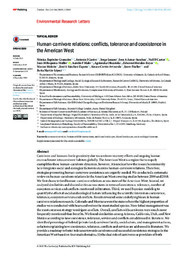Por favor, use este identificador para citar o enlazar este ítem:
https://hdl.handle.net/11000/33893Registro completo de metadatos
| Campo DC | Valor | Lengua/Idioma |
|---|---|---|
| dc.contributor.author | Expósito-Granados, Mónica | - |
| dc.contributor.author | Castro, Antonio J. | - |
| dc.contributor.author | Lozano, Jorge | - |
| dc.contributor.author | Aznar Sanchez, Jose A | - |
| dc.contributor.author | Carter, Neil H | - |
| dc.contributor.author | Requena-Mullor, Juan Miguel | - |
| dc.contributor.author | Malo, Aurelio | - |
| dc.contributor.author | Olszańska, Agnieszka | - |
| dc.contributor.author | Morales-Reyes, Zebensui | - |
| dc.contributor.author | Moleón, Marcos | - |
| dc.contributor.author | Sánchez Zapata, José Antonio | - |
| dc.contributor.author | Cortés-Avizanda, Ainara | - |
| dc.contributor.author | Fischer, Joern | - |
| dc.contributor.author | Martin-Lopez, Berta | - |
| dc.contributor.other | Departamentos de la UMH::Biología Aplicada | es_ES |
| dc.date.accessioned | 2024-11-18T11:11:59Z | - |
| dc.date.available | 2024-11-18T11:11:59Z | - |
| dc.date.created | 2019-12-06 | - |
| dc.identifier.citation | Environmental Research Letter, 14 (2019) 123005 | es_ES |
| dc.identifier.issn | 1748-9326 | - |
| dc.identifier.uri | https://hdl.handle.net/11000/33893 | - |
| dc.description.abstract | Carnivore and humans live in proximity due to carnivore recovery efforts and ongoing human encroachment into carnivore habitats globally. The American West is a region that uniquely exemplifies these human-carnivore dynamics, however, it is unclear how the research community here integrates social and ecological factors to examine human-carnivore relations. Therefore, strategies promoting human-carnivore coexistence are urgently needed. We conducted a systematic review on human-carnivore relations in the American West covering studies between 2000 and 2018. We first characterized human-carnivore relations across states of the American West. Second, we analyzed similarities and dissimilarities across states in terms of coexistence, tolerance, number of ecosystem services and conflicts mentioned in literature. Third, we used Bayesian modeling to quantify the effect of social and ecological factors influencing the scientific interest on coexistence, tolerance, ecosystem services and conflicts. Results revealed some underlying biases in humancarnivore relations research. Colorado and Montana were the states where the highest proportion of studies were conducted with bears and wolves the most studied species. Non-lethal management was the most common strategy to mitigate conflicts. Overall, conflicts with carnivores were much more frequently mentioned than benefits. We found similarities among Arizona, California, Utah, and New Mexico according to how coexistence, tolerance, services and conflicts are addressed in literature. We identified percentage of federal/private land, carnivore family, social actors, and management actions, as factors explaining how coexistence, tolerance, conflicts and services are addressed in literature. We provide a roadmap to foster tolerance towards carnivores and successful coexistence strategies in the American West based on four main domains, (1)the dual role of carnivores as providers of both beneficial and detrimental contributions to people, (2)social-ecological factors underpinning the provision of beneficial and detrimental contributions, (3)the inclusion of diverse actors, and (4) cross-state collaborative management. | es_ES |
| dc.format | application/pdf | es_ES |
| dc.format.extent | 13 | es_ES |
| dc.language.iso | eng | es_ES |
| dc.publisher | IOP Publishing | es_ES |
| dc.rights | info:eu-repo/semantics/openAccess | es_ES |
| dc.rights | Attribution-NonCommercial-NoDerivatives 4.0 Internacional | * |
| dc.rights.uri | http://creativecommons.org/licenses/by-nc-nd/4.0/ | * |
| dc.subject | ecosystem services | es_ES |
| dc.subject | human-wildlife interactions | es_ES |
| dc.subject | multi-use landscapes | es_ES |
| dc.subject | shared landscapes | es_ES |
| dc.subject | socio-ecological systems | es_ES |
| dc.subject.other | CDU::5 - Ciencias puras y naturales::57 - Biología | es_ES |
| dc.title | Human-carnivore relations: conflicts, tolerance and coexistence in the American West | es_ES |
| dc.type | info:eu-repo/semantics/article | es_ES |
| dc.relation.publisherversion | https://doi.org/10.1088/1748-9326/ab5485 | es_ES |

Ver/Abrir:
11.pdf
1,32 MB
Adobe PDF
Compartir:
 La licencia se describe como: Atribución-NonComercial-NoDerivada 4.0 Internacional.
La licencia se describe como: Atribución-NonComercial-NoDerivada 4.0 Internacional.
.png)